|
Wankel
Rotary Engine
Why
(and how) an engine must rev smoothly
|
|
|
Since
time immemorial, research has been aimed at finding substitutes for
classic sources of energy - the muscle power of Man or draft animals.
The
earliest machines used wind or water power; then came the steam engine,
followed by the internal combustion engine. With the internal
combustion engine, designers have had to ensure that the output from
the machine produces a rotary motion, this being necessary for almost
any practical application of the energy produced.
|
|
![[Fig 1]](images/wankel01.gif)
|
|
|
There are two
basic types of internal combustion engines - the conventional
reciprocating piston engine and the rotary piston engine; the former
being characterised by a connecting crank mechanism (the crankshaft)
which transforms the linear motion of the piston into circular
motion.
[Fig 1]
|
Rotary piston
engines do not employ a crankshaft; the linear piston is replaced by a
rotary piston coupled to a rotating shaft which performs an uniform or
variable rotary movement without being affected by alternating inertial
forces due to changes in piston velocity, particularly at top dead
centre and bottom dead centre. Since the motion produced is
rotary, it can be utilised directly without having to be
transformed.
[Fig 2]
|
|
History of
an invention
1588
Ramelli, an
Italian engineer invented a water pump which continues to be used in
oil pumps and compressors.
|
|
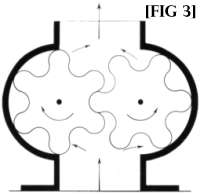
|
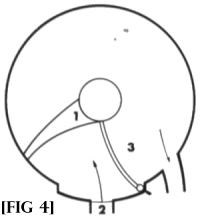
|
|
1636
Pappenheim, a
German engineer invented the gear pump which is still used to lubricate
engines. This gear pump made it possible to dispense with the
reciprocating slide valves used by Ramelli.
[Fig 3]
Pappenheim
drove his machine by an overshot water wheel set in motion by a stream
and was used to feed water fountains. The emperor Ferdinand II
granted him a “privilege” - the equivalent of a patent in respect of
this invention.
Even
in the 17th century, engineers were trying to solve the problem of
“leak-proofing” between moving parts and this problem continues to be
the Achilles heel of the rotary piston engine although Mazda would seem
to have reduced this problem to manageable proportions.
|
1650
Otto von
Guericke built a vacuum pump which employed leather washers to prevent
leakage between cylinder and piston.
1782
James Watt who
invented the steam engine’s connecting rod crank mechanism which made
it possible to convert the piston’s reciprocating motion into rotary
motion designed an oscillating piston machine in which a wing-shaped
rotary blade performed an almost complete revolution uncovering inlet
ports in a chamber separated off by a curved radial wall.
[Fig 4]
|
|
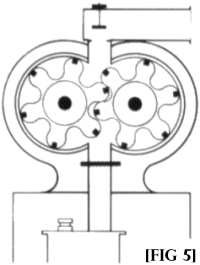
|
|
|
1799
One of Watt’s
co-workers, Murdock, adapted Pappenheim’s gear pump to create a rotary
piston steam engine.
[Fig 5]
|
1846
Elijah Galloway
built the first rotary piston engine with inner epicycloid and
enveloping outer line.
[Fig 6]
|
|
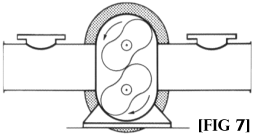
|
|
|
1859
Jones, modified
Pappenheim’s gear pump and produced a double rotor with only two teeth
per gear. Rootes compressors and pumps employ this
principle.
[Fig 7]
|
1900
Alotham and
Franchot designed a vane compressor comprising a bust rotating inside a
cycloidal housing.
[Fig 8]
|
|
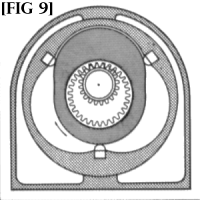
|
|
|
1901
The American,
Cooley, lodged a patent for a rotary piston engine with an internal
epicycloid and enveloping outer chamber.
[Fig 9]
|
1908
The Englishman,
Umpleby, transformed Cooley’s steam engine into an internal combustion
engine but experienced problems with gas tightness.
[Fig 10]
|
|
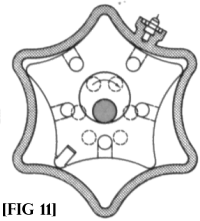
|
|
|
1923
A Swedish
patent was granted to Wallinder and Skoog in respect of a true rotary
piston thermal engine with toothed meshing, enveloping interior
hypocycloid and internal five pointed rotor with a 5:6 rotation ratio
which could be used as either a two or four stroke internal combustion
engine.
[Fig 11]
|
1938
Sensaud and
Lavaud, (the French engineers responsible for the Traction Avant
automatic gearbox which was a failure) applied for a patent for a
rotary piston engine with internally meshing gears in a
hypocycloid housing and a 5:6 reduction ratio. Both Renault and
Citroën, at the instigation of the French Air Ministry provided
backing for this project and a number of engines were built at
Batignolles. Unfortunately the engine failed to live up to
expectations and the project was abandoned.
[Fig 12]
|
|
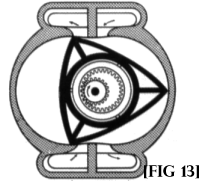
|
1943
The Swiss
manufacturer Bernard Maillard built an air compressor based on a
British patent for a rotary piston machine with a 2:3 ratio and
internal hypocycloid surfaced chambers. Leakage under pressure
made it impossible to use this design as a thermal engine.
[Fig 13]
|
 |
©
1999 Julian Marsh |